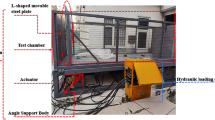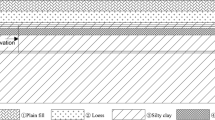Abstract
The tunnel crossing active fault is severely damaged under the action of fault dislocation. Considering the “economic and safety” principle in engineering design, the tunnel damage should be effectively reduced. In this work, a two-level design method for fault dislocation was proposed and the Urumqi subway tunnel in China was chosen as a typical model to deeply investigate its application feasibility. Based on the definition of the design events of different levels and corresponding design goals, three-dimensional finite element soil-tunnel models were established to estimate the response of tunnel. Meanwhile, the rationality of soil-tunnel model was judged by tunnel deformation and internal forces distribution characteristics analysis, and the two-level design goals were evaluated by comparing tunnel damage degree and volumes. The results suggest that under the condition of fault dislocation, the tunnel without disaster mitigation method suffers severely shear, tensile-crack, and compressive damage, which may eventually induce the tunnel collapse. The tunnel damage is reduced significantly by adopting the method of flexible joint. For Urumqi subway tunnel with flexible joints, both of the two-level design goals are effectively realized.



















Similar content being viewed by others
References
Amorosi A, Boldini D (2009) Numerical modelling of the transverse dynamic behavior of circular tunnels in clayey soils. Soil Dyn Earthq Eng 29(6):1059–1072
Anastasopoulos I, Gazetas G (2007) Foundation-structure systems over a rupturing normal fault: part I. Observations after the Kocaeli 1999 earthquake. Bull Earthq Eng 5(3):253–275
Baziar MH, Nabizadeh A, Mehrabi R, Chung JL, Wen YH (2016) Evaluation of underground tunnel response to reverse fault rupture using numerical approach. Soil Dyn Earthq Eng 83:1–17
Baziar MH, Nabizadeh A, Khalafian N, Nader L, Chung J, Hung WY (2020) Evaluation of reverse faulting effects on the mechanical response of tunnel lining using centrifuge tests and numerical analysis. Geotechnique 70(6):490–502
Burridge PB, Scott RF, Hall JF (1989) Centrifuge study of faulting effects on tunnel. J Geotech Eng ASCE 115(7):949–967
Cai QP, Peng JM, Charles WWN, Shi JW, Chen XX (2019) Centrifuge and numerical modelling of tunnel intersected by normal fault rupture in sand. Comput Geotech 111:137–146
Chen GM, Teng JG, Chen JF (2011) Finite-element modeling of intermediate crack debonding in FRP-plated RC beams. J Compos Constr 15(3):339–353
Cui GY, Wang MN, Yu L, Lin GJ (2013) Study on the characteristics and mechanism of seismic damage for tunnel structures on fault rupture zone in Wenchuan seismic disastrous area. China Civil Engineering Journal 46(11):122–127
GB50010 (2010) Code for Design of Concrete Structures. China Architecture & Building Press, Beijing
GB50909 (2014) Code for seismic design of urban rail transit structures. China Planning Press, Beijing
Hashash YMA, Hook JJ, Schmidt B, Yao JIC (2001) Seismic design and analysis of underground structures. Tunn Undergr Sp Tech 16(4):247–293
Hu J, Luan CQ, Hu FQ, Zheng FW, Nan L, Cai ZQ (1996) Neotectonic movement of Xishan fault, Urumqi. Xinjiang Geol 14(3):228–237
Jeeho L, Fenves GL (1998) Plastic-damage model for cyclic loading of concrete structures. J Eng Mech 124(8):892–900
Kiremidjian AS (1984) Reliability of structures subjected to differential fault slip. Earthq Eng Struct Dyn 12:603–618
Lin M, Chung C, Jeng F, Yao TC (2007) The deformation of overburden soil induced by thrust faulting and its impact on underground tunnels. Eng Geol 92(3-4):110–132
Lin DM, Yuan RM, Shang YJ, Bao WX, Wang KY, Zhang ZJ, Li K, He WT (2017) Deformation and failure of a tunnel in the restraining bend of a strike-slip fault zone: an example from Hengshan Mountain, Shanxi Province, China. Bull Eng Geol Environ 76:263–274
Liu XZ, Wang XL, Lin LL (2013a) Model experiment on effect of normal fault with 75°dip angle stick-slip dislocation on highway tunnel. Chin J Rock Mech Eng 32(8):1714–1720
Liu XZ, Lin LL, Wang XL, Li X (2013b) Deformation characteristics of tunnel with flexible joints affected by normal fault stick-slip dislocation. Chin J Rock Mech Eng 32(S2):3546–3551
Liu GZ, Qiao YF, He MC, Fan Y (2020) An analytical solution of longitudinal response of tunnels under the dislocation of active fault. Rock Soil Mech 41(3):1–10
Lubliner J, Oliver J, Oller S, Onate E (1989) A plastic-damage model for concrete. Int J Solids Struct 25(3):299–326
Ma Y, Sheng Q, Zhang GM, Cui Z (2019) A 3D discrete-continuum coupling approach for investigating the deformation and failure mechanism of tunnels across an active fault: a case study of Xianglushan Tunnel. Appl Sci 9(11)
Majid K, Tohid A, Abbas G (2016) Experimental modeling of segmental shallow tunnels in alluvial affected by normal faults. Tunn Undergr Sp Tech 51(1):108–119
Paul Z (1961) Torsional strenth of prestressed concrete members. ACI J 57(4):1337–1360
Ran KY, Chen LC, Shen J, Li J, Gong HL (2007) Xishan fault group near Urumqi city and paleoearthquake identification on reverse fault. Seismology and Geology 29(2):218–235
Rots JG (1988) Computational modeling of concrete fracture, PhD Thesis, Delft University of Technology, Netherlands.
Shahidi AR, Vafaeian M (2005) Analysis of longitudinal profile of the tunnels in the active faulted zone and designing the flexible lining (for Koohrang-III tunnel). Tunn Undergr Sp Tech 20(3):213–221
Shen J, Song HP (2008) Brief introduction on the predominant results of the active fault detecting and seismic risk assessment in Urumqi city. Seismology and Geology 30(1):273–288
Shen YS, Gao B, Yang XM, Tao SJ (2014) Seismic damage mechanism and dynamic deformation characteristic analysis of mountain tunnel after Wenchuan earthquake. Eng Geol 180:85–98
Shi SS (1999) Shear strength, modulus of rigidity and Young’s modulus of concrete. China Civil Engineering Journal 32(2):47–51
Sidoroff F (1981) Description of anisotropie damage application to elasticity. IUTAM Colloquium, Physical Nonlin-earities in Structural Analysis. Springer Verlag, Berlin., 237-244.
SL 191 (2018) Design code for hydraulic concrete structures. China Water & Power Press, Beijing
Tao LJ, Hou S, Zhao X, Qiu WG, Li TB, Liu CX, Wang K (2015) 3-D shell analysis of structure in portal section of mountain tunnel under seismic SH wave action. Tunn Undergr Sp Tech. 46:116–124
Wang WL, Wang TT, Su JJ, Lin CH, Seng CR, Huang TH (2001) Assessment of damage in mountain tunnels due to the Taiwan Chi-Chi Earthquake. Tunn Undergr Sp Tech 16(3):133–150
Wang LP, Zhang W, Luo WW (2018) Seismic hazard analysis method for fault rupture and dislocation based on regional seismicity parameters. Journal of Natural Disasters 27(4):166–170
Yan GM, Shen YS, Gao B, Zheng Q, Fan KX, Huang HF (2020), Damage evolution of tunnel lining with steel reinforced rubber joints under normal faulting: an experimental and numerical investigation. Tunn Undergr Sp Tech 97
Yu HT, Chen JT, Bobet A, Yuan Y (2016) Damage observation and assessment of the Longxi tunnel during the Wenchuan earthquake. Tunn Undergr Sp Tech. 54:102–116
Zhao K, Chen WZ, Zhao WS, Yang DS, Song WP (2018) Study on parameters of articulated design of tunnel lining under reverse fault dislocation. Chin J Rock Mech Eng 37(S1):3412–3421
Zhao K, Chen WZ, Yang DS, Zhao WS, Wang SY, Song WP (2019) Mechanical tests and engineering applicability of fibre plastic concrete used in tunnel design in active fault zones. Tunn Undergr Sp Tech 88(2):200–208
Funding
The research described in this paper is financially supported by the National Natural Science Foundation of China (No. 41877218).
Author information
Authors and Affiliations
Corresponding author
Rights and permissions
About this article
Cite this article
An, S., Tao, L.J., Han, X.C. et al. Application of two-level design method on subway tunnel crossing active fault: a case study on Urumqi subway tunnel intersected by reverse fault dislocation. Bull Eng Geol Environ 80, 3871–3884 (2021). https://doi.org/10.1007/s10064-021-02164-y
Received:
Accepted:
Published:
Issue Date:
DOI: https://doi.org/10.1007/s10064-021-02164-y




